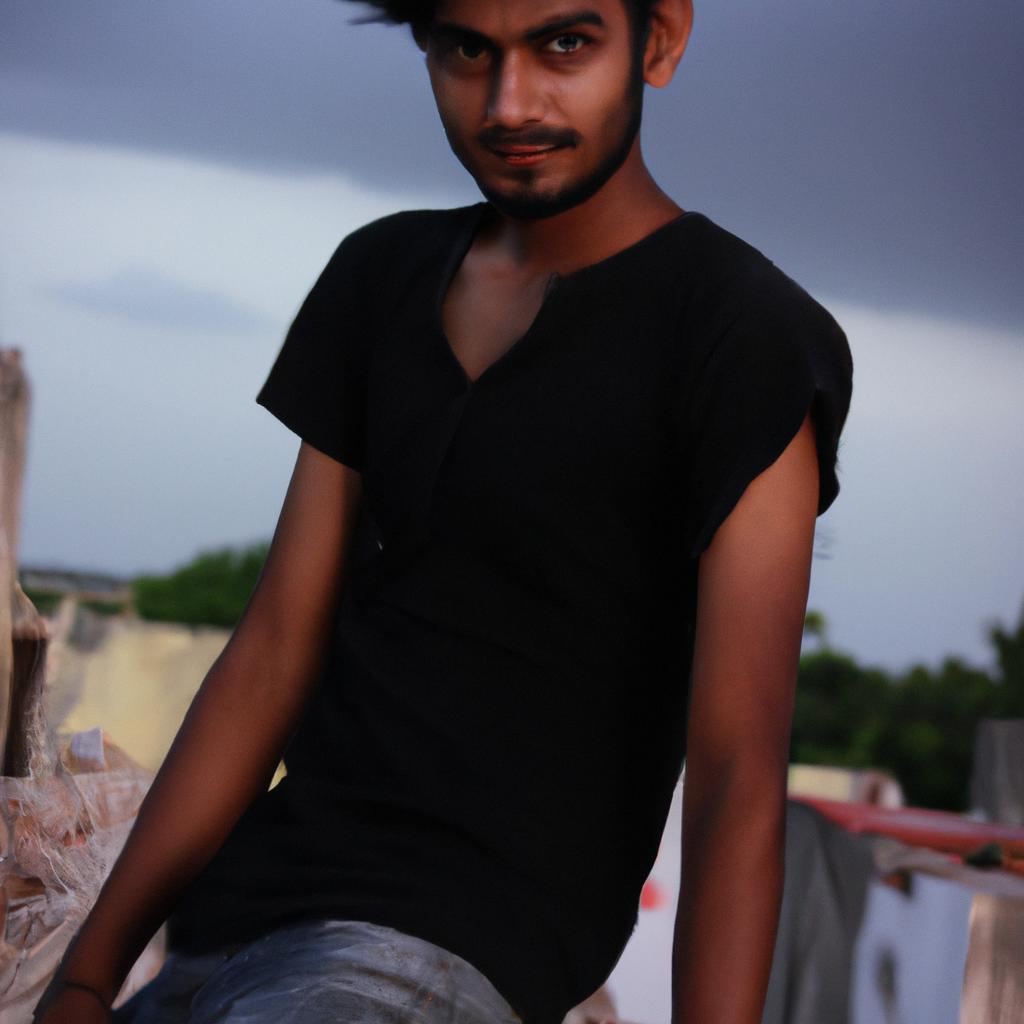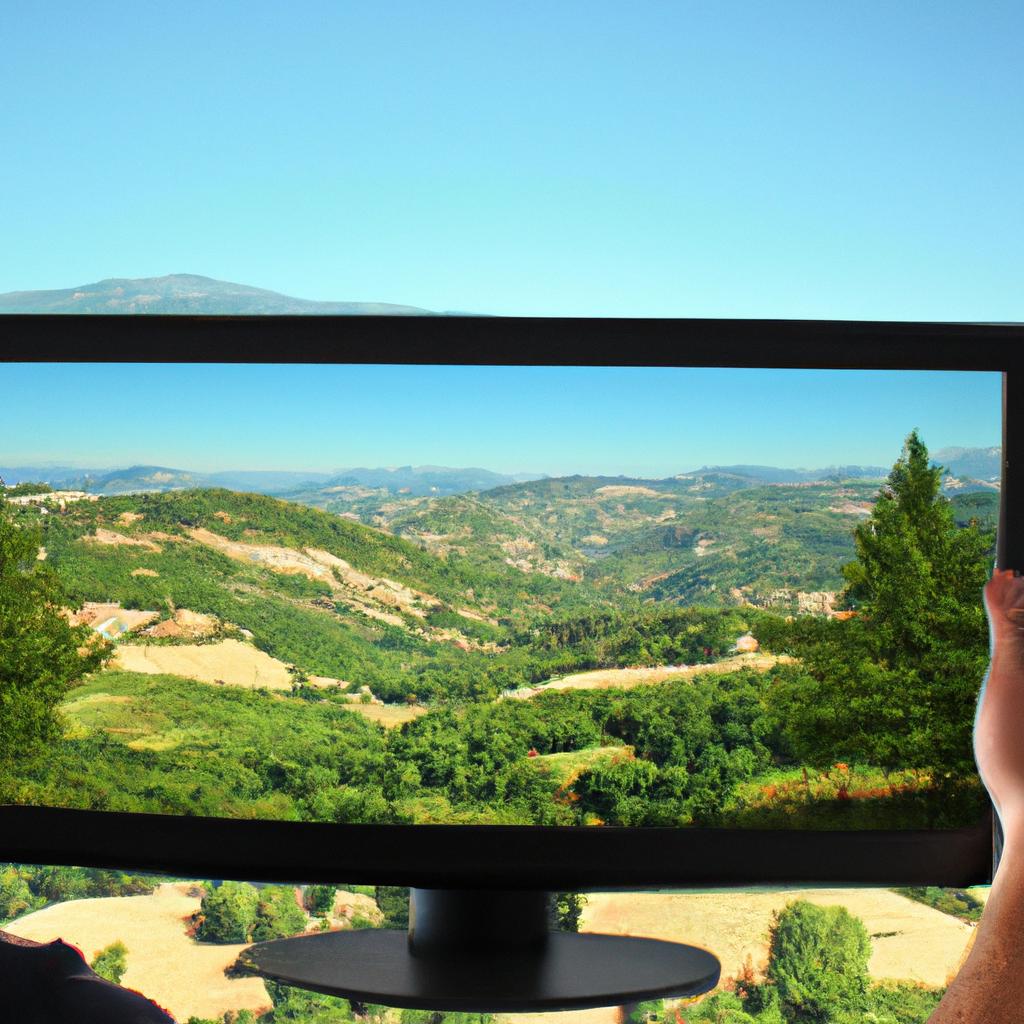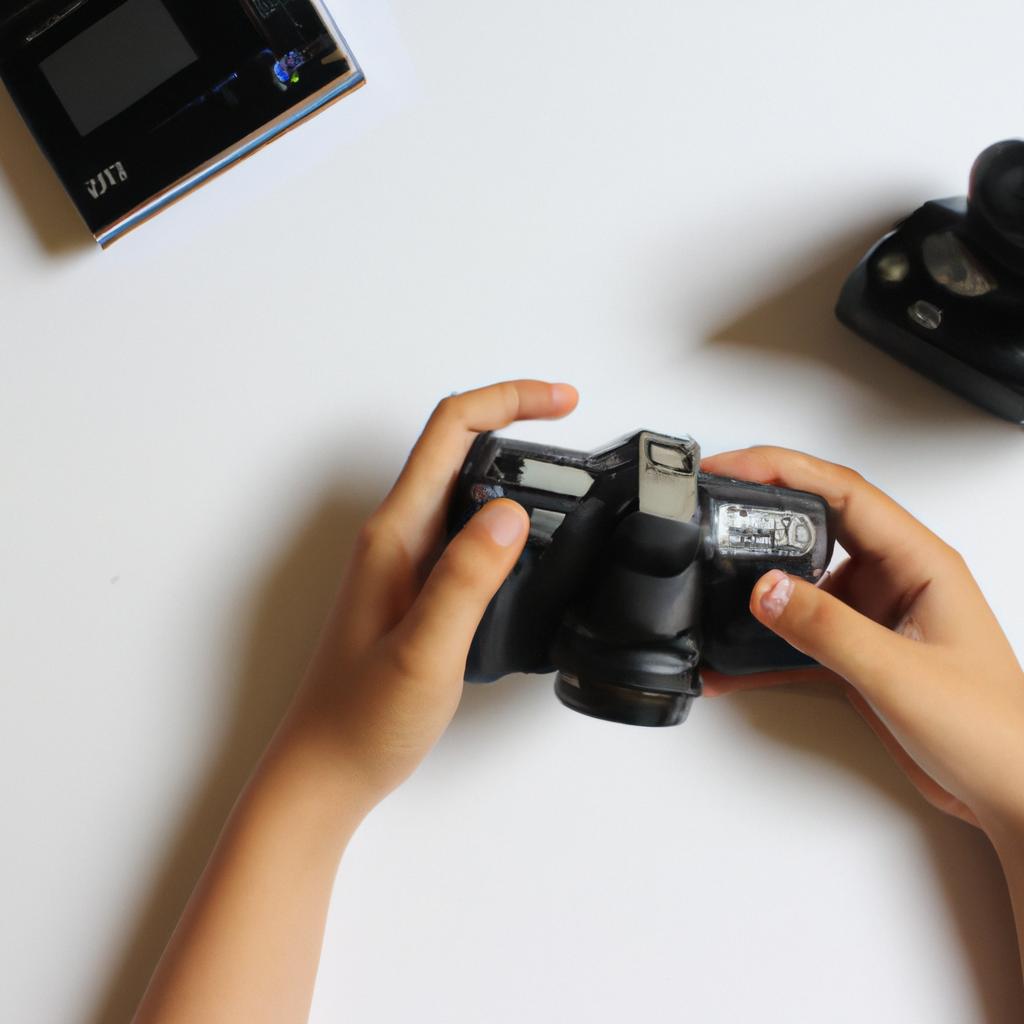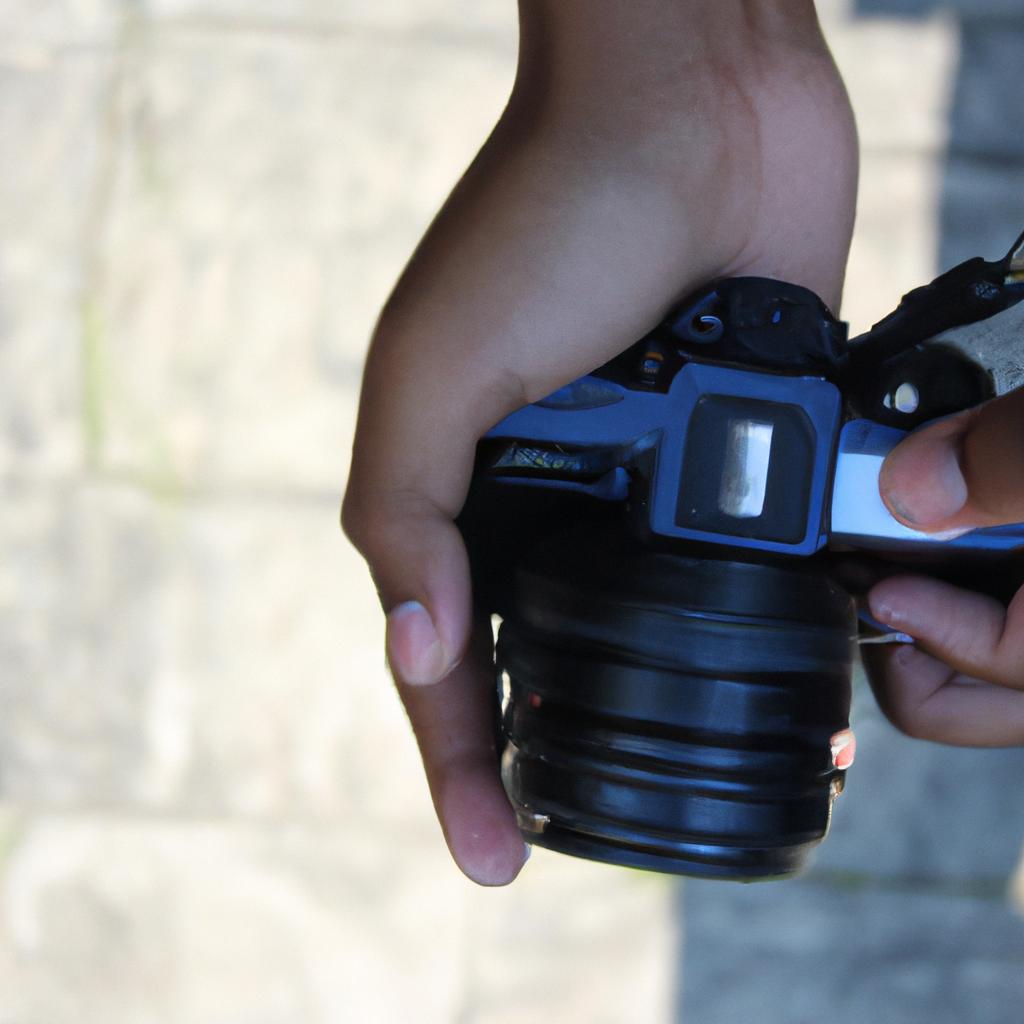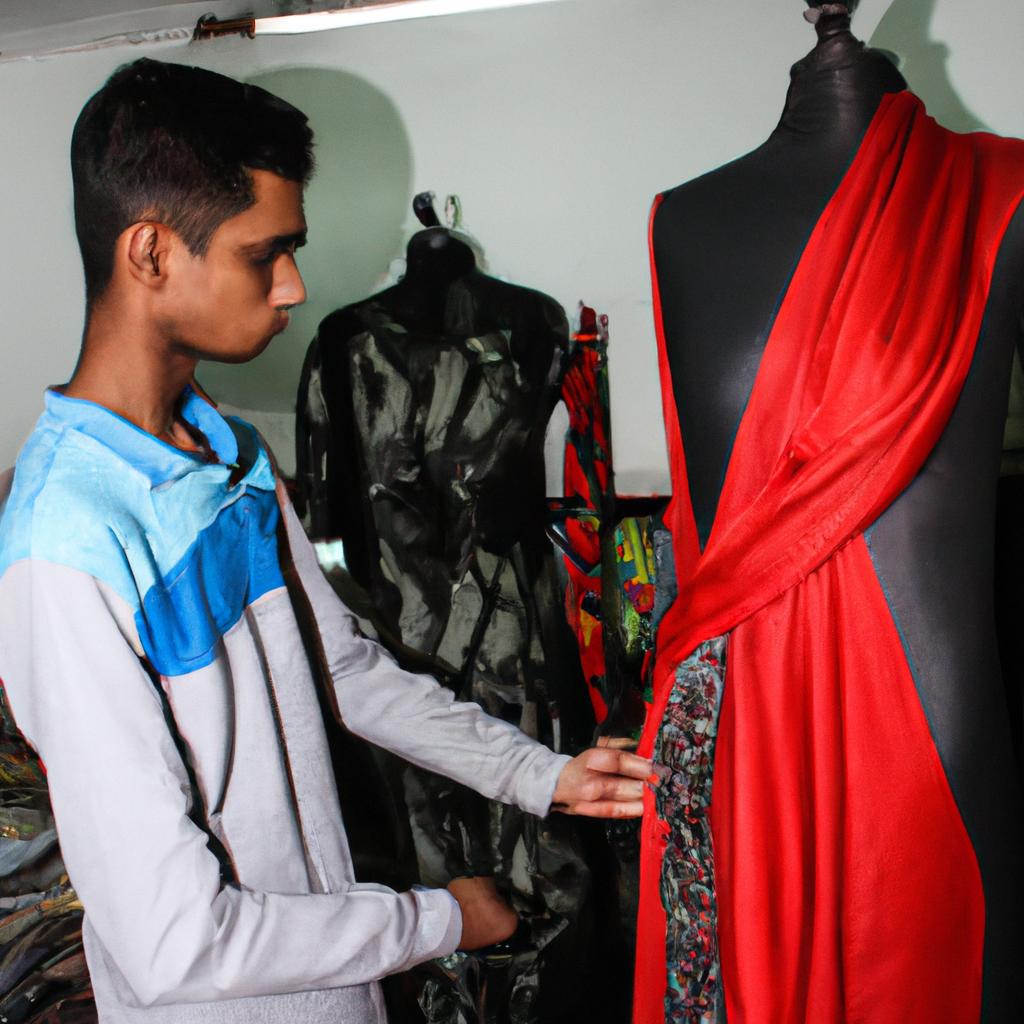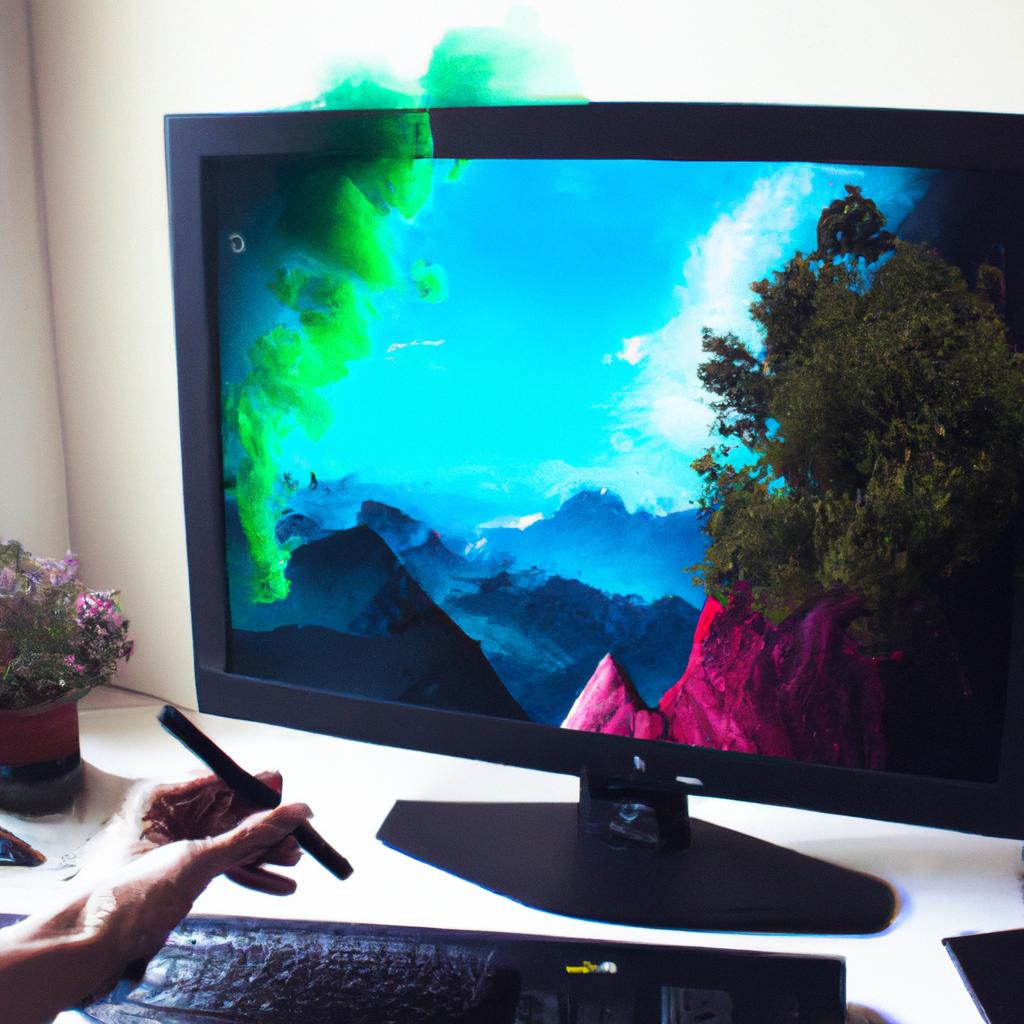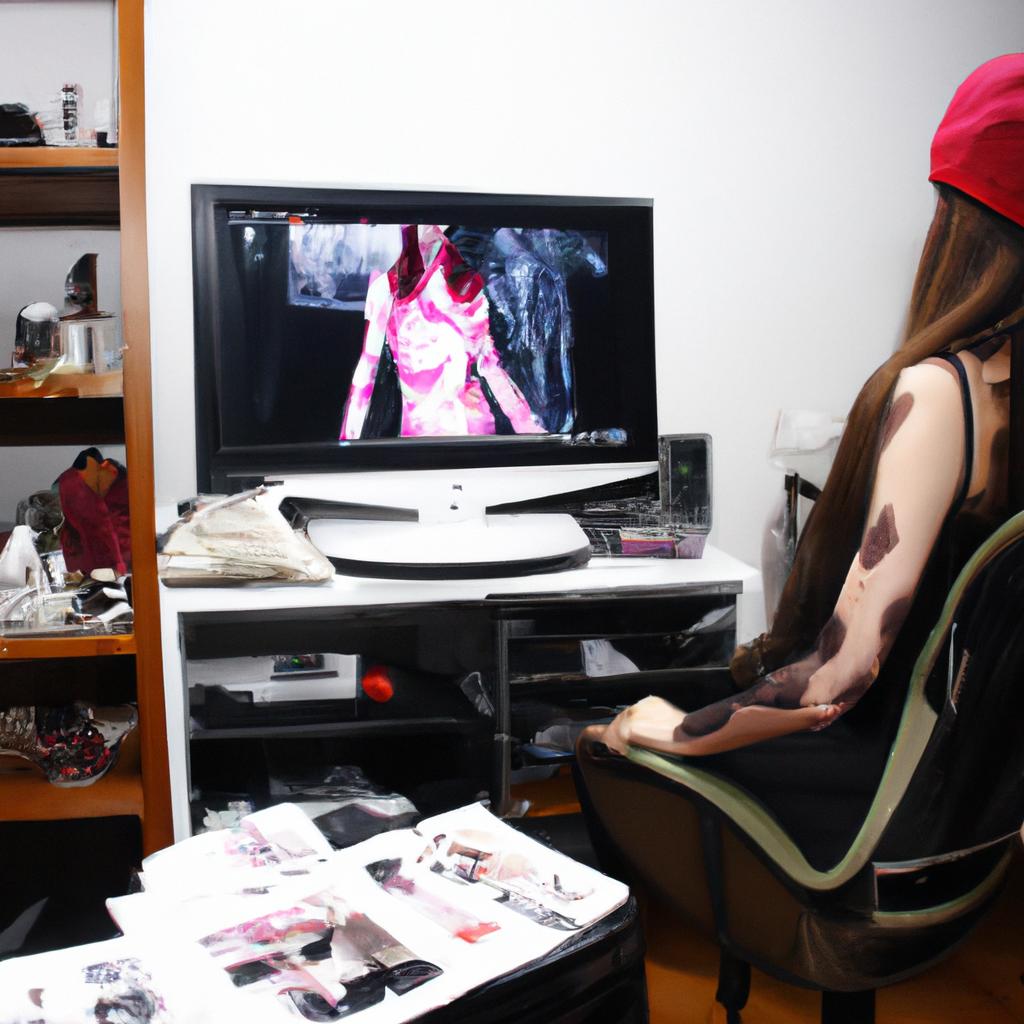Fashion photography has long been recognized as a form of artistic expression, capturing the essence and beauty of clothing designs in visually captivating ways. In recent years, however, fashion photography has found itself intersecting with the world of television, creating new opportunities for both industries to collaborate and thrive. This article explores this intriguing intersection between arts and television within the realm of fashion photography, examining how these two mediums have come together to shape contemporary visual culture.
One compelling example that showcases the fusion of fashion photography and television is the popular reality TV show “America’s Next Top Model.” In each episode, aspiring models are challenged to showcase their talent through various photoshoots where they must embody different styles and concepts. These photoshoots are often overseen by renowned fashion photographers who guide the contestants in creating evocative images that convey specific emotions or narratives. By bringing together the worlds of high-fashion photography and television entertainment, “America’s Next Top Model” exemplifies how these two art forms can complement each other, allowing viewers to witness firsthand the creative process behind iconic fashion imagery while also providing an engaging narrative arc.
The Evolution of Fashion Photography
In the world of fashion, photography plays a crucial role in capturing and conveying the essence of style. Over the years, fashion photography has undergone a significant evolution, adapting to new technologies and societal changes. To illustrate this point, let’s consider an example: In the early 20th century, when black-and-white film was the norm, photographers primarily focused on showcasing garments with simple studio lighting setups. However, as color imagery became more accessible and popularized in magazines and advertisements, fashion photographers began experimenting with vibrant settings and creative compositions to captivate their audience.
One way to understand the evolution of fashion photography is through a list of its defining characteristics:
- Emphasis on clothing: Historically, fashion photography aimed at highlighting apparel by placing it front and center. The focus was on presenting garments in a visually appealing manner that would entice potential consumers.
- Collaboration between artists: Throughout history, there have been notable collaborations between photographers and designers or stylists. This partnership allowed for the fusion of different artistic perspectives to create captivating visuals that showcase both clothing and overall aesthetics.
- Integration of technology: As advancements such as digital cameras emerged alongside post-processing software, fashion photography embraced these tools to enhance images further. Techniques like retouching and manipulation helped achieve desired outcomes while pushing boundaries creatively.
- Exploration of narratives: Contemporary fashion photography often seeks to tell stories beyond mere product promotion. By employing models in various poses or incorporating symbolic elements into compositions, photographers can evoke emotions or convey broader concepts related to culture, identity, or social issues.
To better comprehend how these factors intertwine within the realm of fashion photography’s evolution, we can examine them using a table format:
| Characteristic | Example |
|---|---|
| Emphasis on clothing | A photograph featuring intricate couture dresses displayed prominently against minimalist backgrounds |
| Collaboration between artists | Notable partnerships include Richard Avedon working alongside designer Yves Saint Laurent in the 1960s |
| Integration of technology | The use of post-processing software to create vibrant and surrealistic effects on images |
| Exploration of narratives | A photo series challenging beauty standards by showcasing diverse body types |
Understanding the evolution of fashion photography sets the stage for exploring its intersection with television. As we delve further into this connection, it becomes clear how television’s influence has shaped contemporary fashion aesthetics and consumption patterns.
The Influence of Television on Fashion
The Evolution of Fashion Photography has paved the way for its intersection with television, resulting in a dynamic relationship that continues to shape contemporary fashion media. As technology advanced and television became more accessible to the masses, it opened up new avenues for fashion photography to reach a wider audience. This section explores the influence of television on fashion and how it has transformed the field.
One notable example is the popular reality TV show “America’s Next Top Model.” The show not only provided aspiring models with a platform to showcase their talent but also offered viewers an inside look into the world of high-fashion photography. By documenting photo shoots, runway challenges, and critiques from industry professionals, “America’s Next Top Model” brought fashion photography into living rooms across America, captivating audiences and inspiring young individuals interested in pursuing careers in this field.
Television’s impact on fashion photography can be further understood through several key aspects:
- Exposure: Television broadcasts have enabled photographers’ works to be seen by millions around the world instantly.
- Collaboration: Fashion photographers now collaborate closely with directors, producers, stylists, and makeup artists to create visually stunning images that complement televised fashion shows or advertisements.
- Storytelling: Television allows for narratives within fashion photography, presenting stories behind designers’ collections or capturing moments during events like Fashion Week.
- Innovation: The merge of fashion photography and television has pushed boundaries creatively as photographers experiment with different techniques and styles to stand out amidst competition.
To illustrate these points further, consider the following table showcasing various ways in which television has influenced fashion photography:
| Aspect | Influence |
|---|---|
| Global Reach | Provides instant exposure worldwide |
| Dynamic Collaborations | Encourages collaborations between photographers and other creatives |
| Narrative-driven Content | Allows storytelling within images |
| Pushing Creative Boundaries | Inspires innovation and experimentation |
In conclusion, television’s impact on fashion photography has been transformative. As the medium continues to evolve, so does its influence on this art form. The next section will delve deeper into how fashion photography has emerged as a distinct and influential form of artistic expression.
With an understanding of television’s impact on fashion photography, we can now explore how it has elevated the field as a unique and powerful form of art.
Fashion Photography as a Form of Art
The Influence of Television on Fashion Photography
Television has had a profound impact on the world of fashion, shaping trends and inspiring new forms of artistic expression. One notable example is the rise of reality TV shows centered around fashion, such as “America’s Next Top Model” or “Project Runway.” These programs have not only brought fashion into the living rooms of millions but have also given birth to a new genre of photography – fashion photography that captures both the glamour and drama associated with these television productions.
Fashion photographers today face unique challenges in capturing the essence of fashion influenced by television. They must navigate between showcasing clothing designs while incorporating elements from popular reality TV shows. To achieve this delicate balance, they employ various techniques that merge artistry with commercial appeal:
- Innovative storytelling: Fashion photographers now incorporate narrative elements into their work inspired by the dramatic arcs commonly found in reality TV shows. By creating visual narratives through their photographs, they engage viewers emotionally, evoking feelings akin to those experienced while watching their favorite characters unfold on screen.
- Dynamic composition: Television often employs dynamic angles and unconventional camera movements for dramatic effect. Similarly, fashion photographers experiment with different perspectives and compositions to create visually striking images that capture attention and convey a sense of movement.
- Emotional lighting: Lighting plays a crucial role in setting the mood on television screens, enhancing emotions felt by viewers during pivotal moments. Fashion photographers draw inspiration from this concept by using creative lighting techniques to evoke specific moods or enhance certain aspects of an outfit.
- Celebrity influence: Reality TV stars have become influential figures in contemporary culture, impacting trends and consumer behavior. In response, many fashion photographers collaborate with these celebrities to create captivating images that resonate with audiences who admire them.
To further illustrate the intersection between arts and television within fashion photography, consider the following table that highlights key characteristics shared by both mediums:
| Television | Fashion Photography |
|---|---|
| Storytelling | Narrative-driven imagery |
| Dynamic camera angles | Experimental compositions |
| Emotional engagement | Evocative lighting |
| Celebrity influence | Collaborations with stars |
As fashion photography continues to evolve, it is clear that television will remain an influential force. From storytelling techniques to composition choices and collaborations with celebrities, the impact of television on this art form cannot be overstated.
Transitioning seamlessly into the subsequent section about “The Role of Fashion Photographers in Television,” we explore how these photographers navigate the world of television productions and contribute to creating captivating visual content for broadcasts.
The Role of Fashion Photographers in Television
Fashion Photography as a Form of Art has established its place in the creative realm, but it also holds significant importance in the world of television. By seamlessly blending artistic vision with commercial interests, fashion photographers have made substantial contributions to the visual aesthetics and narratives presented on screen. This section will explore The Role of Fashion Photographers in Television by examining their impact on advertising campaigns, TV shows, and even live events.
One notable example is the collaboration between renowned fashion photographer Mario Testino and luxury brand Burberry for their Spring/Summer 2015 campaign. Testino’s expertise in capturing striking images that tell stories through style played an integral role in bringing the brand’s vision to life on both print advertisements and television commercials. His ability to create visually captivating scenes not only elevated Burberry’s brand identity but also served as inspiration for other fashion photographers working within the medium of television.
The presence of fashion photographers in television can be seen through various ways:
- Visual storytelling: Fashion photographers possess a unique skill set that allows them to translate complex ideas into compelling visuals. Their keen eye for composition, lighting, and styling enables them to craft aesthetically pleasing shots that resonate with viewers emotionally.
- Creating distinct moods: Fashion photography often aims to evoke specific emotions or atmospheres through color schemes, props, and models’ expressions. When applied to television productions, this expertise helps enhance scenes by setting particular tones or conveying underlying themes effectively.
- Shaping brand identities: In televised advertisements or branding segments, fashion photographers contribute significantly to establishing and reinforcing a brand’s image. They play an instrumental role in defining how a product or company is perceived by leveraging their understanding of visual communication.
- Elevating live events: From red carpet coverage at award shows to runway presentations during fashion weeks, fashion photographers bring their talents behind-the-scenes at live events. Through quick thinking and capturing decisive moments with precision, they showcase the essence of these occasions, ensuring that the visual narrative matches the overall experience.
The table below highlights some of the ways fashion photographers contribute to television:
| Contribution | Description |
|---|---|
| Visual storytelling | Fashion photographers use their expertise to tell stories through style. |
| Creating moods | They set particular tones and convey underlying themes effectively. |
| Shaping identities | Fashion photographers help establish a brand’s image in TV productions. |
| Elevating live events | Behind-the-scenes coverage captures the essence of live occasions. |
Fashion photographers’ role in television extends beyond capturing beautiful images; they are instrumental in shaping narratives, enhancing branding efforts, and creating visually compelling moments on screen. As we transition into exploring Fashion Photography Techniques in Television, it becomes evident how these professionals employ their artistic skills in a medium that demands both creativity and commercial appeal.
Fashion Photography Techniques in Television
Having explored the significant role that fashion photographers play in television, it is now essential to delve into the various techniques they employ to capture compelling imagery. By employing a range of innovative approaches, these photographers enhance the visual appeal of televised fashion presentations while also conveying powerful messages. To illustrate this further, let us consider a hypothetical case study involving a high-profile fashion show broadcasted on live television.
Section – Fashion Photography Techniques in Television:
In such a scenario, fashion photographers employ an array of techniques to effectively showcase garments and create visually captivating images for television audiences. These techniques often involve careful consideration of lighting, composition, and styling choices. Here are some key methods employed by fashion photographers within the realm of television:
-
Strategic Lighting Placement:
- Correctly positioning lights enhances the visibility of intricate details on garments.
- Manipulating light intensity creates dramatic effects that accentuate textures and silhouettes.
- Utilizing colored gels alters the overall mood and ambiance captured on camera.
-
Dynamic Composition:
- Framing shots creatively draws attention to specific elements or features.
- Experimenting with angles can introduce unique perspectives and add visual interest.
- Incorporating negative space allows viewers’ focus to be directed towards important aspects.
-
Effective Styling Choices:
- Collaborating with stylists ensures ensembles are presented harmoniously on screen.
- Selecting appropriate accessories complements outfits and enhances their overall aesthetic appeal.
- Paying attention to hair and makeup details ensures cohesive looks that align with designers’ visions.
To illustrate how these techniques come together seamlessly, consider the following table showcasing before-and-after shots taken during our hypothetical fashion show:
| Before | After |
|---|---|
| Image A | Image B |
 |
 |
In the ‘before’ image, lackluster lighting and suboptimal composition fail to capture the essence of the garment effectively. However, in the ‘after’ image, strategic lighting placement combined with dynamic composition showcases the outfit’s intricate details while simultaneously creating a visually captivating moment.
By adopting such techniques, fashion photographers are capable of transforming an ordinary television broadcast into a visual spectacle brimming with creativity and allure. Their ability to harness these skills not only enhances their own artistic endeavors but also elevates televised fashion presentations for viewers worldwide.
As we have explored how fashion photography techniques enhance television broadcasts, it is crucial now to discuss the broader impact of this art form on popular culture. Understanding its influence will provide valuable insights into why fashion photography continues to captivate audiences across various media platforms.
The Impact of Fashion Photography on Pop Culture
With the advent of fashion photography, the realm of television programming has been significantly influenced by its techniques and aesthetics. This section explores how fashion photography has seamlessly integrated into television production, enhancing visual storytelling and captivating audiences.
One notable example that showcases the intersection between fashion photography and television is the popular reality show “America’s Next Top Model.” In this series, aspiring models are put through various challenges to test their modeling skills, including photoshoots that often emulate high-fashion editorials. By incorporating elements such as lighting techniques, unique backdrops, and avant-garde poses commonly found in fashion photography, the show not only captures visually striking images but also enhances the overall viewing experience.
To further illustrate the impact of fashion photography on television programming, we can consider a few key aspects:
- Visual Storytelling: Fashion photography techniques help convey narratives effectively through images. By utilizing innovative camera angles and composition choices inspired by fashion shoots, TV shows can create visually compelling scenes that captivate viewers.
- Emotion Elicitation: Through carefully curated visuals reminiscent of fashion editorials, television programs evoke emotional responses from audiences. Whether it is evoking desire for luxury goods or inspiring self-expression through personal style, these visuals tap into viewers’ aspirations and desires.
- Brand Integration: With branded content becoming increasingly prevalent in modern media, fashion photography techniques allow for seamless integration of products within TV shows. Strategic placement of clothing items or accessories during episodes not only serves as subtle promotion but also adds an element of authenticity to the overall narrative.
- Cultural Impact: Fashion photographers often push boundaries with their artistic expressions and challenge societal norms. When translated onto television screens, these bold statements become part of pop culture dialogue — influencing trends, challenging beauty standards, and shaping public perceptions.
The following table highlights some specific ways in which fashion photography intersects with different genres of television programming:
| Genre | Fashion Photography Influence |
|---|---|
| Reality TV | Emulating high-fashion editorials in photoshoot challenges |
| Soap Operas | Creating visually captivating love or conflict scenes |
| Crime Dramas | Utilizing moody lighting techniques for atmospheric shots |
| Period Dramas | Recreating historical fashion trends through styling |
Fashion photography’s impact on television programming goes beyond aesthetic enhancements. By incorporating its techniques, shows are able to engage viewers emotionally and contribute to the broader cultural dialogue surrounding fashion and visual arts.
Overall, it is evident that fashion photography has seamlessly integrated into television production, revolutionizing storytelling techniques and captivating audiences worldwide. As this influence continues to evolve, we can expect even more innovative collaborations between these two mediums.

